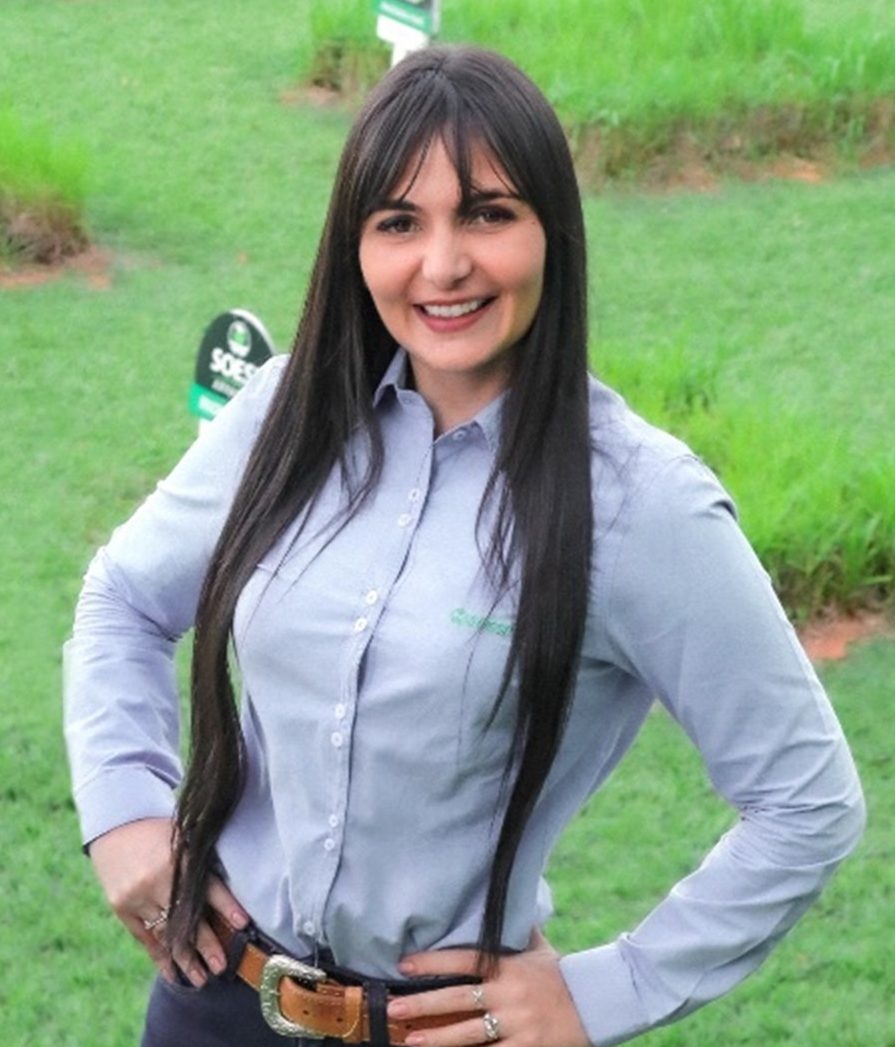“Industrial Seed Treatment based on limestone or gypsum tends to form a much heavier, less uniform, and more fragile finish…”
Marina Lima is a seed and sustainability technician at Sementes Oeste Paulista – SOESP, has a degree in zootechnics (animal science) from UFRRJ, a M.Sc. and Ph.D. in zootechnics from UFV.

Marina Lima, technician at SOESP
AgriBrasilis – Are livestock farmers aware of the importance of pasture seed treatment?
Marina Lima – In a way, yes, but the large number of pasture seed treatments available on the market often leads to doubts among farmers about the effectiveness of the treatment, and it is up to the sales representative to clarify this. Therefore, it is important to purchase quality seeds from certified companies and to pay attention to what is actually present in the treatment applied to the seed. For example, does it contain fungicide and insecticide? Is the treatment based on polymers, limestone and gypsum, or is it just a seed with graphite? This is an example of a question that farmers should ask the sales people to truly understand what the benefit will be in their farm.
“It is important to be sure that they are purchasing seeds with high agronomic value and within the standards required by the Ministry of Agriculture”
AgriBrasilis – What does IST – Industrial Seeds Treatment consist of and what are its advantages?
Marina Lima – It is a technological process that allows the addition of protective agents to the seed, for example: fungicide, insecticide and other materials that will provide better survival of the seed in the soil, protecting it from attacks by fungi and ants and thus ensuring a higher success rate in seed germination. In addition, by knowing how to choose a seed with a good IST, the farmer will have access to a material with excellent plantability, allowing for larger planting ranges, uniform distribution, resistant treatment and with greater cost-benefit.
AgriBrasilis – Why are polymers and graphite used in seeds treatment?
Marina Lima – The polymer is used to help with the adhesion of fungicide and insecticide, as well as to enable a light treatment with a fine and uniform finish. Another advantage of this treatment is an increased resistance to mechanical stress, meaning the seeds will not break during planting.
The graphite helps with the “plantability” of the material, providing greater fluidity during planting, as it reduces friction between the seeds and the planting equipment, facilitating distribution.
AgriBrasilis – How effective are limestone and gypsum treatments?
Marina Lima – IST based on limestone or gypsum tends to form a much heavier, less uniform, and more fragile finished product. This over-treatment, in addition to making it difficult to plant and germinate the seed in the field, significantly reduces the amount of seeds in the package, since the higher the proportion of limestone and gypsum in the treatment, the lower the amount of seeds per kg.
AgriBrasilis – What are the most important characteristics when choosing seeds for pasture?
Marina Lima – Farmers should look for reputable companies that are already well-established in the market. They should not risk the success of their farm with materials of dubious origin. It is important to be sure that they are purchasing seeds with high agronomic value [seed quality index] and within the standards required by the Ministry of Agriculture.
IST in forage seeds is a technology available to farmers and offers excellent benefit-cost ratio. However, it is important for farmers to know how to compare the best options on the market, so as not to buy a “pig in a poke”. It is necessary to compare treatments in terms of their uniformity, resistance, protection, plantability and, most importantly, the cost per hectare. There are different IST processes available on the market, each with its own recommendation in kg/ha, and this choice will directly impact the success of pasture formation.
AgriBrasilis – Which cultivars are best suited for hay and silage production in Brazil?
Marina Lima – For hay production, it is important to choose forages that have a good nutritional value and thinner leaves and stems, which will promote an accelerated dehydration of the forage, such as: Panicum maximum: Massai and BRS Tamani, Brachiaria decumbens, Brachiaria brizantha cv. BRS Piatã and Marandu. For silage production, it is important to choose forage plants with high dry mass production and nutritional value, such as the Panicum maximum cultivars: BRS Zuri, BRS Kenya and Mombaça. Among the Brachiaria brizantha cultivars, we can highlight: BRS Piatã, Xaraés and Marandu.
AgriBrasilis – How to produce forage crops with greater nutritional value for livestock?
Marina Lima – Each forage plant has its own characteristics, which are defined when breeders develop a new cultivar. However, the crop management during pasture formation, such as fertilization and correct grazing – that is, harvesting this forage at the correct time, respecting the height at which animals enter and exit the area – will ensure forage plants with greater nutritional value for the animals.
AgriBrasilis – What technologies and products are provided by SOESP?
Marina Lima – SOESP sells seeds with Advanced technology, which uses two fungicides and one insecticide, polymer and graphite, to ensure a greater protection until germination, in addition to high purity and viability. This entire technological process ensures a quality index of 80% for Brachiaria spp. and Panicum maximum seeds. There are more than 15 forage cultivars available in our portfolio. The seeds are also sold as part of our conventional product line.
READ MORE:

